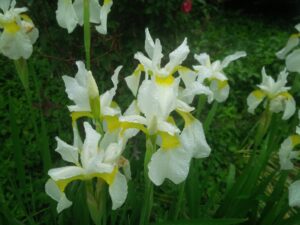 Tall iris time is here—with a vengeance. Last month, the gardens in my neighborhood sparkled with species like Iris cristata and Iris reticulata, dainty varieties that ornament the earth in early spring. Now the statuesque show horses of the Iridaceaee or iris world are enjoying their moment in the sun.
Tall iris time is here—with a vengeance. Last month, the gardens in my neighborhood sparkled with species like Iris cristata and Iris reticulata, dainty varieties that ornament the earth in early spring. Now the statuesque show horses of the Iridaceaee or iris world are enjoying their moment in the sun.
In my garden, something unusual is happening this year–the bearded and Siberian iris are blooming almost simultaneously, providing color, contrast and abundance in the beds. I love the big, blowsy bearded iris, with their fluffy heads and showy “beards”, but I think the Siberians are the most elegant. The flowers have the same configuration as other closely related types—three tall petals or “standards” towering over somewhat wider, downward-turned petals or “falls”. Siberian flowers are generally smaller, with a slenderer profile than their bearded relatives. The Siberians also differ in having no fuzzy “beards” on the falls.
The stalks that bear those beardless blooms sprout from rhizomes or fleshy roots and stand atop tall, slender stems that can rise up to three feet. The foliage has been widely described as “grass-like”, much thinner than the fat, sword-shaped leaves of bearded iris. The leaves persist long after the flowers depart the scene, but can be cut back. Even the seedpods are attractive, slender and brown with several seed-filled chambers. I generally leave them on the plants for winter interest. My more artistic mother would have plucked them, spray painted them gold, and arranged them as holiday decorations.
“Siberians” are actually only Siberian descendants. Their forbearers were two, blue-flowered species, Iris siberica and Iris sanguinea, that found their way from western and/or central Asia to northern Europe. According to the experts at the Royal Botanic Gardens at Kew in England, Iris sibirica appeared in Western Europe in the Middle Ages and was originally planted in monastery gardens, as well as the gardens of the wealthy. Over time, the two species were cross-bred to produce the Siberian-type iris hybrids that are widely cultivated today. By contrast, the blue-flowered parent species that gave the group its name is virtually unavailable in commerce now.
Siberian iris bloom in most of the same colors as their relatives in other iris groups: blue, blue-purple, white, yellow and bi- or tri-colors that combine those shades. Opening from slender buds, the flowers are not particularly long-lasting—on the plant or cut for indoor arrangements. Cool late spring weather helps them stay around just a bit longer.
Siberian iris like sun and consistently moist soil, but can withstand all kinds of garden difficulties like heavy clay, drought, erosion and various browsing critters. In fact one of the distinguishing traits of many cultivated members of the Iridaceae family is their critter-resistance. This is something to bear in mind for those of us who suffer from regular visits from Mr. Antlers and his comrades in garden destruction, the groundhogs.
Vendors offer a host of varieties, but all have the same cultural requirements. Plant the rhizome one to two inches below the soil surface and separate them by a couple of inches. The best time to plant is earliest spring or very late summer. Water regularly to get the roots established. After a few years, you may notice that your Siberians have expanded into a circle, with nothing sprouting from the center and fewer blooms coming up in the spring. This means that they need dividing. Dig up the entire clump, remove the dead plant material from the center and divide the clump into four or more pieces. Replant the divisions separately and each one should produce new, healthy flowers by the following year or year after.
My garden is home to an ever-increasing supply of vigorous white-flowered iris that I have divided many times. Several years ago, I decided that I needed some contrast, and installed some dark purple ones. They are not quite as vigorous, but now there are enough plants to serve as a nice contrast to all that whiteness. The white ones are like vivid punctuation marks in the landscape and they are an inspiration, even though their bloom time is relatively short.
Siberians make an especially nice picture when planted on the side of a stream or pond, where they can be reflected in the water in a fashion reminiscent of Monet. They thrive on the moisture in such conditions. A swathe of the plants on a hillside is also a wonderful sight.
If you are not lucky enough to have a water feature or a hillside, Siberian iris will work very well in a garden bed or border, probably towards the middle or rear. If you have a container garden where you can switch out liners filled with seasonal plants as they go in and out of bloom, Siberians can fill a late spring container, possibly accented with some shorter plants that spill over the sides.
For an excellent selection of Siberians and other iris, try White Flower Farm, P.O. Box 50 ~ Litchfield, Connecticut 06759; (800)503-9624; www.whiteflowerfarm.com. Print catalog available.
